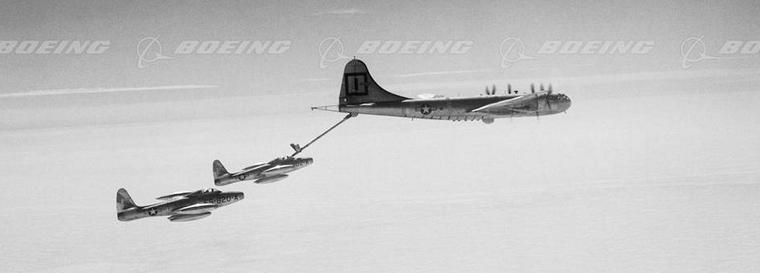A short history of Aerial Refuelling
Aerial refuelling, also referred to as air refuelling, in-flight refuelling (IFR), air-to-air refuelling (AAR), and tanking, is the process of transferring aviation fuel from one military aircraft (the tanker) to another (the receiver) during flight.
The two main refuelling systems are probe-and-drogue, which is simpler to adapt to existing aircraft, and the flying boom, which offers faster fuel transfer, but requires a dedicated boom operator station.

Arial Refuelling in 1923. Photo Public Domain / commons.wikimedia.org
Some of the earliest experiments in aerial refuelling took place in the 1920s; two slow-flying aircraft flew in formation, with a hose run down from a hand-held fuel tank on one aircraft and placed into the usual fuel filler of the other. The first mid-air refuelling, based on the development of Alexander P. de Seversky, between two planes occurred on June 27, 1923 between two Airco DH-4B biplanes of the United States Army Air Service.

Grapple line system in 1935. Photo Public Domain / commons.wikimedia.org
Sir Alan Cobham's Grappled-line looped-hose air-to-air refuelling system borrowed from techniques patented by David Nicolson and John Lord and was publicly demonstrated for the first time in 1935. In the system the receiver aircraft, at one time an Airspeed Courier, trailed a steel cable which was then grappled by a line shot from the tanker, a Handley Page Type W10. The line was then drawn back into the tanker where the receiver's cable was connected to the refuelling hose. The receiver could then haul back in its cable bringing the hose to it. Once the hose was connected, the tanker climbed sufficiently above the receiver aircraft to allow the fuel to flow under gravity.

Probe and drogue. US Navy photographer / commons.wikimedia.org
Cobham's company FRL soon realized that their looped-hose system left a lot to be desired and began work on an improved system that is now commonly called the probe-and-drogue air-to-air refuelling system and today is one of the two systems chosen by air forces for air-to-air refuelling, the other being the flying-boom system. In post-war trials the RAF used a modified Lancaster tanker employing the much improved probe-and-drogue system, with a modified Gloster Meteor F.3 jet fighter, serial EE397, fitted with a nose-mounted probe.

B-29 and F 84 Thunderjets. Photo Boeing
The first use of aerial refuelling in combat took place during the Korean War, involving F-84 fighter-bombers flying missions from Japanese airfields, due to Chinese-North Korean forces overrunning many of the bases for jet aircraft in South Korea, refuelling from converted B-29s using the drogue-and-probe in-flight refuelling system with the probe located in one of the F-84's wing-tip fuel tanks.
|
   |























